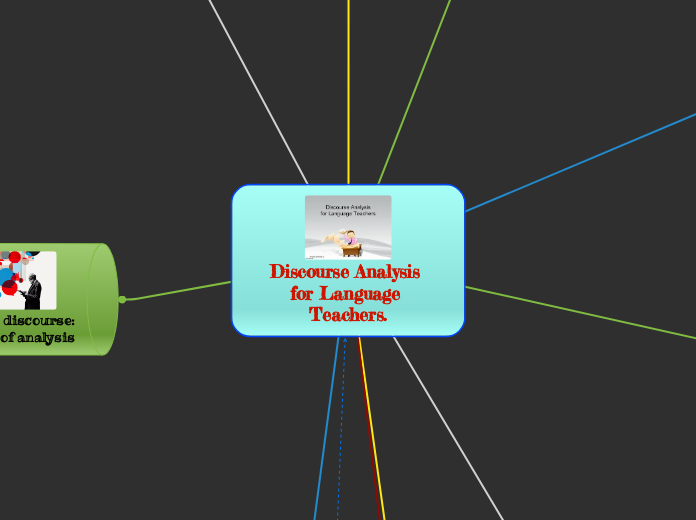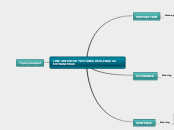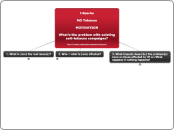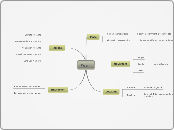Conclusion
"Discourse Analysis for Language Teachers"
The chapter concludes with a reflection on these questions.
Halliday's perspective on language
For a more complete and applied understanding of the language.
He stresses the importance of incorporating these concepts into language teaching
As social action it is revealed as a key issue,
Stands out
And
Deepens the analysis of written discourse
Broader patterns in the text.
Including the relationship between text and interpretation
Speech as a social activity
Discursive.
Michael McCarthy
Historical overview of discourse analysis
Examines speech acts and structures.
Explore the interconnection between the form
function of language
Discourse Analysis for Language Teachers.
Conversations outside the classroom.
Sinclair and Coulthard's model
has complications
in informal contexts
analysis of
Patterns of interaction
Structured talking
Rank scale
ACT
referred as
acts
by
Coulthard
Sinclair
MOVE
EXCHANGE
TRANSACTION
Descriptive categories
Input and output
evaluated
in teaching/learning process
Accurate targets
in language teaching
Discourse analysis
allows to
Describe performances
Starter
before the elicitation
Initiating move
Gives background
Free and unstructured conversations
force
Sinclair-Coulthard model
to be improved
different
Speech-acts labels
to describe
What is happening
aparently
Have structure
Traditional Classroom
Not "real" conversation
Pupils
limited speakers
Teacher
evaluate answers
asks questions
Transactions
Heavily marked
easy to perceive
Patterns of
Rigidly defined
varied structuring
Spoken discourse: models of analysis
Sinclair and Coulthard's pattern
Exchange
New formula
depends on
Settings
Comment
A: Thanks
Follow-up
Answer
B: Six thirty
Response
Question
A: What time is it?
Initiation
Transactions with framing moves
Limited words
Used by everyone
Among others
"So"
Examples
Job interview
"Ok"
"Well now"
Telephone calls
Transaction
what is done
with language
Framing moves
plus
Question/answers
Frame move
function of
Utterances
Frame
Mini-hases set by words
set by words
"Right"
"Now then"
Birmingham model
captures patterns
offers
herarchical model
consists of
smaller unites
form
larger units
Reflection of
Functions of interaction
Describes talking
out the classroom
in the classroom
Conexions with
Speech acts
Capture the "Wholes"
Powerful
Simple
Concerned
Structure of discourse
Speech acts and discourse structures
• Beginnings, middles and ends.
Relationship between language and the contexts of its use.
Interested in the process.
Inverted verb and subject.
Informing speech act.
key features of the situation.
surrounding text
'functions'
• Request.
• Instruction.
• Exemplification.
Speech
Speech acts.
• Have you ever . . . ?",
• Tell me about the time you . . . ?",
• I hear you once . . . ?", "Didn't you once . . . ?
• You've . . ., haven't you.
Larger patterns in text
This text talks about how the clause-relational approach examines common patterns in texts, such as problem and solution.
Highlights the importance
The reader's interpretation.
and create texts that facilitate
To understand textual relationships
That readers and writers be aware of these devices
These patterns, analyzed by
Hoey (1983)
Grammatical and lexical devices.
And are marked by
Are frequent in texts
Use an example of carrying a camera when traveling to show
response and evaluation
Problem
A sequence of situation
Text and interpretation.
The text explores the importance of cohesive markers in creating links in discourse
Winter and Hoey's analysis
is presented as an approach
Dynamic relational-clause.
An example is used about a python attacking a child
Besides
And the relationship between textual segments
To understand the structure and coherence of the text.
The interpretation of textual patterns is mentioned
To illustrate how the reader must contribute knowledge
And
make connections to understand the text
with a focus on reader interpretation
It highlights that
creating cognitive links to achieve coherence.
activating the reader's knowledge
Interpreting a text involves
Written discourse
It is necessary to consider
When preparing
Have
the opportunity
to reflect and reflect
about the message
and the way you say it.
The sentences
generally
so that they are not
expressions of
a natural and spontaneous conversation
they are well formed
Talk as a social activity.
When we have
a spontaneous dialogue
diagram will vary.
how people behave
cooperate
in the speech process
the use of adjacency pairs
Themes come and go
everyone can say something
turn taking
how it is managed
the closing of the conversation
the opening
a casual dialogue
Form and function
Discuorse analysis
Conventions
Rules
Roles
Interpretation of grammatical forms
factors
intonation
situation
British comedy duo, Eric Morecambe and Ernie Wise
How we interpret grammatical forms depends on a number of factors:
some purely situational
some linguistic
Eric was playing with a grammatical structure that seems to be ambiguous:
'Have we got a show for you!' has an inverted verb and subject.
They started one' of their shows in 1973 with a short dialogue :
This raises a number of problems for anyone wishing to do a linguistic analysis of it
1973
A brief historical overview.
Austin,Searle and Grice
Dell Hymes
Zelling Harris
Halliday
Structure of speech and writing
Social functions of language
British speech
Discourse analysts
study language in use:
Spoken data
Written texts
It grew out of work in different disciplines
sociology
anthropology
psychology
semiotics
linguistics
Relationship between
contexts
language
Origin
1960
The scope of discourse analysis
Evaluate the descriptions on which the teaching is based.
whether in spoken
or written form
what happens in the classroom
the final products of our teaching
The teaching materials
Description and analysis of spoken interaction.
spoken
and
interaction.
Organisation of written interaction.
daily activities
that
develop in our lives









